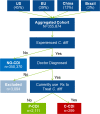Impaired Quality of Life, Work, and Activities Among Adults with Clostridium difficile Infection: A Multinational Survey
- PMID: 30074110
- PMCID: PMC6182443
- DOI: 10.1007/s10620-018-5222-1
Impaired Quality of Life, Work, and Activities Among Adults with Clostridium difficile Infection: A Multinational Survey
Abstract
Background: Evidence of humanistic detriments of Clostridium difficile infection (CDI) remains limited.
Aims: To assess humanistic burden associated with CDI.
Methods: Self-reported National Health and Wellness Survey data between 2013 and 2016 were analyzed for the USA, five European countries, China, and Brazil. Outcome measures included SF-36v2® for health-related quality of life (HRQoL) and Work Productivity and Activity Impairment questionnaire. Respondents (≥ 18 years old) were classified as (1) currently treated doctor-diagnosed CDI (C-CDI), (2) doctor-diagnosed prior CDI (P-CDI), or (3) never experienced CDI (NO-CDI). Regression modeling assessed the association between CDI status and outcomes, adjusting for potential confounders.
Results: Of 352,780 respondents, 299, 2111, and 350,370 met the criteria for C-CDI, P-CDI, and NO-CDI, respectively, with 45% of the total from the USA. C-CDI and P-CDI respondents were older, were less often employed and had more comorbidities than those with NO-CDI. After adjustment for covariates, C-CDI and P-CDI had significantly lower HRQoL relative to NO-CDI for mental (MCS 39, 43 vs. 46) and physical (PCS 39, 41 vs. 46) component summary scores, and health utility (SF-6D 0.58, 0.64 vs. 0.71) (all p < 0.05), meeting common thresholds for minimally important differences. Those with C-CDI and P-CDI reported missing more work (21, 16 vs. 8%), greater impairment while working (43, 34 vs. 22%), and more activity impairment (61, 49 vs. 34%) than those with NO-CDI (all p < 0.05), respectively.
Conclusions: CDI is associated with meaningfully worse HRQoL and greater impairment to work and activities compared with NO-CDI. The impairment directly attributable to CDI requires further evaluation.
Keywords: Clostridium difficile; Outcomes; Quality of life; Questionnaire; Survey; Work productivity.
Conflict of interest statement
HK, YH, VJ, CR, and HJ are employees and stockholders of Pfizer, Inc., the study sponsor. ZM has received compensation as a consultant to Pfizer, Inc., including for the development of this manuscript. She has also received research and/or consulting funding from Merck, The Medicines Company, Astellas, Melinta, Tetraphase, and Paratek. Editorial support was provided by Scott Vuocolo of Pfizer, Inc.
Figures





References
-
- Miller BA, Chen LF, Sexton DJ, Anderson DJ. Comparison of the burdens of hospital-onset, healthcare facility-associated Clostridium difficile infection and of healthcare-associated infection due to methicillin-resistant Staphylococcus aureus in community hospitals. Infect Control Hosp Epidemiol. 2011;32:387–390. doi: 10.1086/659156. - DOI - PubMed
-
- Centers for Disease Control and Prevention [CDC] Antibiotic resistance threats in the United States. Washington, DC: Centers for Disease Control and Prevention; 2013.
Publication types
MeSH terms
LinkOut - more resources
Full Text Sources
Other Literature Sources
Miscellaneous

